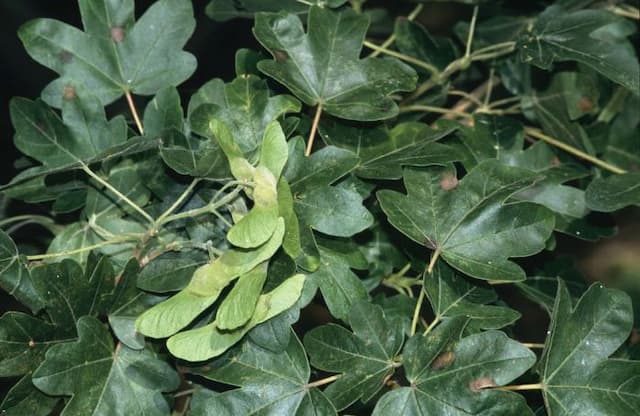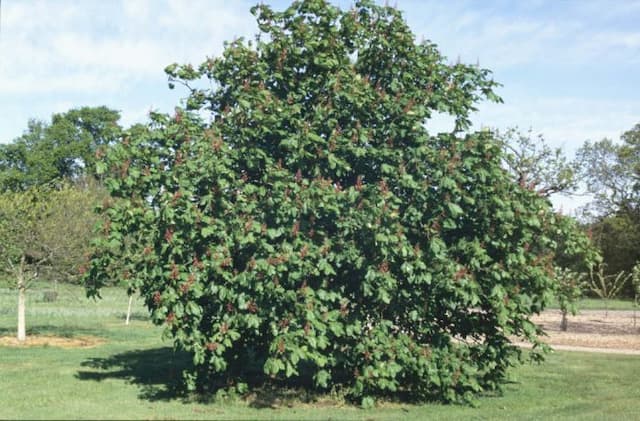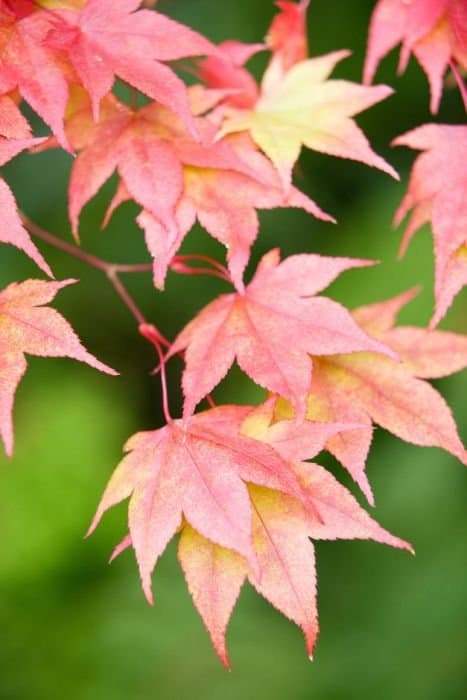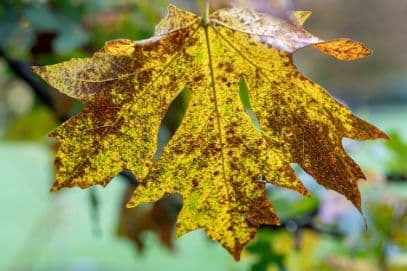Horse chestnut Aesculus hippocastanum

ABOUT
Commonly known as the horse chestnut, this plant is notable for its large, compound leaves that spread out like the fingers of a hand, generally comprising five to seven leaflets. Each leaflet is broad with a toothed margin, creating a lush, green canopy. During spring, the horse chestnut produces pyramidal clusters of white flowers, each blossom touched with a delicate pink or yellow blotch at the base. These clusters are quite impressive and can be dense with blooms. After flowering, the plant produces its distinctive spiny capsules that contain one to three brown, shiny seeds, often called conkers. The bark of the horse chestnut is rugged and dark, with twisting ridges throughout. Overall, the appearance of the horse chestnut is robust, with a rounded and spreading outline that gives it a grand and stately presence.
About this plant
 Names
NamesFamily
Sapindaceae.
Synonyms
Horse Chestnut, Conker Tree, Buckeye.
Common names
Aesculus asplenifolia, Aesculus castanea, Hippocastanum vulgare.
 Characteristics
CharacteristicsLife cycle
Perennials
Foliage type
Deciduous
Color of leaves
Green
Flower color
White
Height
50 feet (15 meters)
Spread
40 feet (12 meters)
Plant type
Tree
Hardiness zones
3
Native area
Southeast Europe
Benefits
 General Benefits
General Benefits- Shade provider - The Horse Chestnut tree is known for its dense canopy, offering considerable shade in parks and large gardens.
- Ornamental value - Its showy white to pink flowers, often arranged in upright panicles, add aesthetic value to landscapes.
- Wildlife support - Its flowers are a source of nectar and pollen for bees and other pollinating insects.
- Erosion control - With its extensive root system, it can help stabilize the soil and prevent erosion.
- Urban greening - Suitable for city environments, it can enhance urban areas by adding green space and improving the urban ecosystem.
- Recreational space - Mature trees can create a natural meeting point or rest area with their broad shadow and bench-like tree bases.
- Education - The Horse Chestnut tree is often used in educational contexts to teach about plant biology, history, and ecology due to its distinct features.
- Seasonal interest - Its changing foliage colors throughout the seasons offer a dynamic visual display from spring to autumn.
- Historical significance - Often planted on historic estates and public grounds, it has heritage value in many communities.
- Wood production - Though not a primary timber tree, its wood can be used for furniture, wood carvings, and utility objects.
 Medical Properties
Medical Properties- Venotonic effect: Horse chestnut seed extract is used for its venotonic effect, helping to increase venous tone and reduce the appearance of varicose veins.
- Anti-inflammatory properties: The plant has anti-inflammatory properties that may reduce swelling and inflammation associated with chronic venous insufficiency.
- Edema reduction: It can help reduce edema, or fluid retention, particularly in the legs, associated with various vein disorders.
- Antioxidant content: Horse chestnut seeds contain antioxidants which may protect the veins from damage caused by free radicals.
- Astringent: The plant's astringent qualities can help to shrink and tighten the mucous membranes, aiding in the treatment of hemorrhoids.
 Air-purifying Qualities
Air-purifying QualitiesThis plant is not specifically known for air purifying qualities.
 Other Uses
Other Uses- Leather Tanning: Aesculus hippocastanum, commonly known as Horse Chestnut, contains tannins that can be used in the leather tanning process to help preserve the material.
- Water Purification: The seeds have been used with their saponin content to purify water by helping to precipitate out impurities.
- Soap Making: The saponins in Horse Chestnut can be extracted and used as a natural soap or detergent alternative.
- Photographic Plates: The Horse Chestnut tree's seeds were historically used to prepare a solution for the cleaning of photographic plates.
- Furniture Polish: Oils extracted from the seeds have been used in some regions to create a natural furniture polish.
- Laundry: The saponins from the nuts can provide a gentle cleansing action and have traditionally been used for washing delicate fabrics.
- Shampoo: The high saponin content in nuts makes them useful in creating natural shampoos, especially for treating dandruff.
- Seed Necklaces: The shiny brown seeds have been used to make necklaces and other jewelry.
- Biodynamic Preparations: Horse Chestnut is sometimes used in biodynamic agriculture for its qualities that are believed to influence soil health and plant growth.
- Fishing: Ground Horse Chestnut has been used as a fish poison in some cultures to help with capturing fish, though this is not an environmentally friendly practice and is commonly illegal.
Interesting Facts
 Feng Shui
Feng ShuiThe Horse Chestnut is not used in Feng Shui practice.
 Zodiac Sign Compitability
Zodiac Sign CompitabilityThe Horse Chestnut is not used in astrology practice.
 Plant Symbolism
Plant Symbolism- Strength and Endurance: The Horse Chestnut (Aesculus hippocastanum) is known to symbolize strength and endurance due to its large and hardy nature.
- Protection: In some cultures, planting a Horse Chestnut near a home is believed to guard against negative energy, symbolizing protection.
- Prosperity: The conkers (seeds) of the Horse Chestnut are sometimes carried as talismans, believed to attract wealth and ensure economic stability.
- Health and Vitality: Its use in traditional medicine has associated the Horse Chestnut tree with health and vitality.
 Water
WaterThe Horse Chestnut tree requires deep watering to establish a strong root system. It's best to water this tree every one to two weeks, depending on the weather conditions, with approximately 15-20 gallons each time for young trees. Mature trees will need less frequent watering but with higher volume, potentially up to 30-50 gallons per session during dry periods. Ensure that the soil around the tree is moist but not waterlogged to prevent root rot. Gradually reduce watering as the tree becomes established.
 Light
LightThe Horse Chestnut flourishes in full sun to partial shade. The ideal spot for planting this tree would be a location where it receives at least four to six hours of direct sunlight daily. While it can tolerate some shade, too little light can lead to sparse foliage and poor flowering.
 Temperature
TemperatureHorse Chestnut trees are hardy and can withstand cold temperatures, making them suitable for planting in areas where winter temperatures can drop to around -20 to -30°F. During the growing season, they thrive in temperatures ranging from 50°F to 75°F. These trees can tolerate a summer high up to about 90°F but benefit from cooler temperatures.
 Pruning
PruningPruning the Horse Chestnut tree is essential to remove any dead or damaged branches and to maintain a strong structure. The best time for pruning is during the dormant season, usually late winter before new growth begins. Prune the tree every two to three years to ensure its health and appearance.
 Cleaning
CleaningAs needed
 Soil
SoilHorse Chestnut trees thrive in deep, fertile, and well-drained loamy soil with a pH range of 6.0 to 7.0. A mix of loam, well-rotted compost or manure, and a small amount of sand for drainage makes the best soil mix for Horse Chestnut.
 Repotting
RepottingHorse Chestnut trees are large and are not commonly repotted. They are typically planted outdoors where they have space to grow. If started in a container, young Horse Chestnuts should be planted into the ground after a couple of years.
 Humidity & Misting
Humidity & MistingHorse Chestnut trees are tolerant of a wide range of humidity levels and do well in the natural outdoor environment where the humidity is not controlled.
 Suitable locations
Suitable locationsIndoor
Growing Horse Chestnuts indoors is not practical due to size.
Outdoor
Plant Horse Chestnut in well-draining soil; full sun.
Hardiness zone
3-8 USDA
 Life cycle
Life cycleAesculus hippocastanum, commonly known as the horse chestnut, begins its life cycle with seed germination, which occurs in spring after the seeds undergo a period of cold stratification through the winter. The germinated seedling develops a taproot and foliage, eventually growing into a sapling. As the sapling matures, it transitions to the vegetative growth stage, where it develops a strong woody trunk and branching canopy over several years. Once mature, the horse chestnut produces clusters of white, pink, or red flowers in erect panicles during late spring, which are pollinated by insects. Following pollination, the flowers develop into green, spiky capsules that contain shiny brown seeds, or "conkers." The tree enters a period of dormancy in the winter, shedding its leaves and halting growth until the cycle resumes with the next spring.
 Propogation
PropogationPropogation time
Spring-Early Summer
The most common common name for Aesculus hippocastanum is the horse chestnut tree. Propagation of horse chestnut is typically conducted in the fall after the seeds have fallen from the tree. The popular method involves collecting the seeds, which are the shiny brown nuts encased in a spiky green husk, and sowing them immediately as they do not store well and quickly lose viability. They should be planted in a cold frame or a similar protected environment about 2 inches (approximately 5 cm) deep in a mixture of peat and sand. The natural cold stratification process throughout the winter will break the seed's dormancy, leading to germination in the spring. Once the seedlings emerge and grow strong enough, young trees can be transplanted to their final location in the following autumn.









